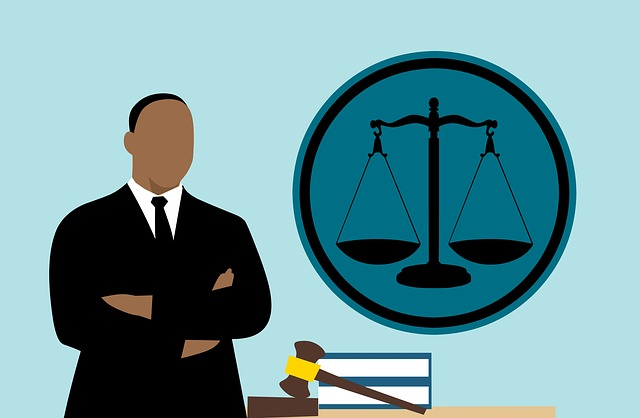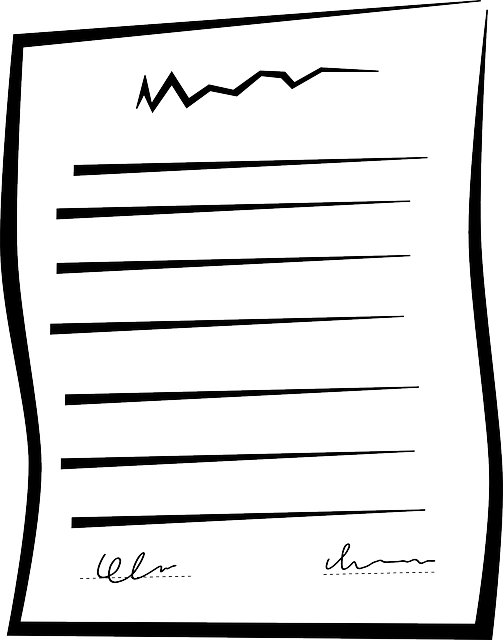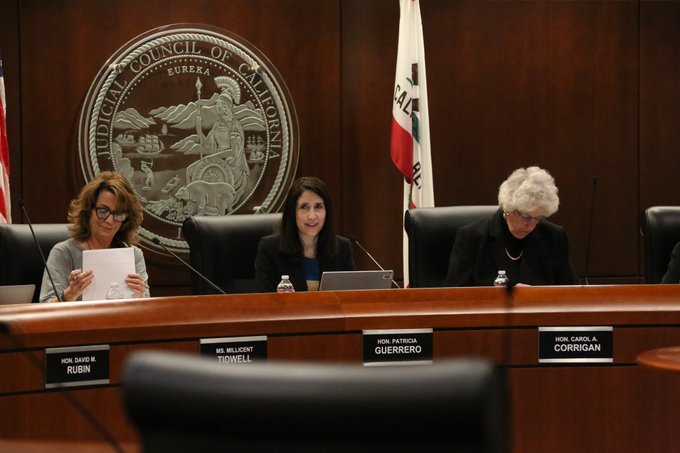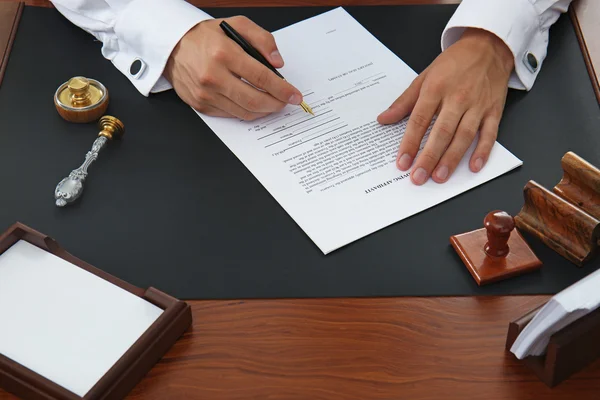What is a Declaration in a Family Law Case?

A declaration is a document submitted to the judge of a California court where the writer swears that the contents, under penalty of perjury, are true and correct. A declaration often contains sensitive information about the facts of the case. Declarations can be used for different reasons such as when the declarant (writer) is unavailable to testify or to provide admissible evidence prior to a trial.
When is a Declaration Used in a Family Law Case?
A declaration is used under certain circumstances in which witnesses wish to make a statement based upon personal knowledge and provide a correct copy of their would-be statement in court, but they cannot go to court due to circumstances due to their inability to serve as a witness. This could be because the circumstances of the court make it difficult or impossible for them to attend.
The law for drafting a declaration is very complicated. While there is a form that you can use, you can also do a declaration on pleading paper. In this article, we will explain the law as it pertains to declarations.
Example of How to Draft a Declaration in a Family Law Case

How to draft a declaration in a family court hearing:

A good testimony will tell a story. For example, if the other parent in family court is a horrible person or individual who has stolen the bank account numbers, you can make a statement in the form of a declaration describing the circumstances of what occurred. California law requires that testimony be made under penalty of perjury and that the person making the testimony have personal knowledge of the facts. There is also a judicial council form that you can find here.
How Much Detail Should a Declaration Have?
The declaration should be detailed while providing a chronological order of events to facilitate the reader’s understanding of the underlying facts concerning the parties. You should consider all of the surrounding circumstances when drafting the declaration. If it is a custody issue, the document should contain information about the other parent’s side and have an explanation about the issue and the witnesses that were there to describe it.
Important Legal Rules and an Example Declaration Demonstrating How to Draft a Declaration
The declaring party must follow the rules under California law. For example, the declaration must be in writing, and it must be made under penalty of perjury. An example of the rule and the language a testimony should use is this:
“I declare under penalty of perjury that the foregoing statement is true and correct. If called to testify, I could and would do so competently.”
The declaration must also provide the California county in which it was made. It must have a date. The filing date of a statement is also important. A local court will often have a rule that addresses the filing of a statement, and the act of doing so will put the statement before the court.
Does an Attorney Have to Write the Declaration?
No, an Attorney does not have to write the declaration. An attorney can be helpful, and it is advisable to have an attorney in a case so that they can help decide if the writing is properly done and can help with the conclusion of the documents. An attorney can provide an example of a statement and can further assist a party in understanding the laws explaining the testimony and the penalty of false testimony under California laws. It is common practice for an attorney to write the testimony under most circumstances if you have an attorney.
Are Declarations in Lieu of Witness Testimony Admissible?
Witnesses that have a relationship to the case can reach a conclusion in a declaration wherein they state the facts of the case and hope that their declaration shall be considered as proof to the court of law. The statement documents can provide evidence in lieu of testimony to help the court of law to decide issues of fact or law. Once declared, the laws of the State of California allow the introduction of statements so long as notice and service of process is given to the opposing party. A person who has declared a fact upon which they have personal knowledge is submitting documents to the court so that the court of law can take notice of the declared document.
The Content of the Declaration
Write the key facts, in your own words explaining your side of the story and why your side of the issue is correct. In the declaration, you may be asked to respond to the opposing party’s questions or possibly the declaration of the opposing party. Try to answer the opposing party’s questions in the same story-like manner. Remember, just tell the story from your perspective.
You should expect to revise your declaration at least once or twice so that you don’t miss any important details. You will want to provide factual information to support your conclusions. A good rule of writing is to state the facts first, then state your personal knowledge and understanding about how that fact affected your actions or understanding of the situation.
The written declarations usually end with a statement swearing that the content of the declaration is true and would be your actual testimony if you were given live testimony in a court hearing. The end of the Declaration will also contain language that indicates that under penalty of perjury, the writer swears to the truth of live testimony of the information presented.
Use of Declarations in a California Court Hearing

Do you want to know the rule on what qualifies a written statement to be a declaration? Well, I will explain that here. A declaration is a written statement made under penalty of perjury in which the party is declaring that the facts are true and correct. The act of signing a statement is made under oath. It is generally an admissible form of evidence in the form of writing. For example, a child of a relationship in a California family case can draft a statement and the party can submit that to the judge.
Sometimes you want a court to do something (motion), for example, sometimes this request is in the form of a statement. In these situations, first and foremost, begin by telling the court in plain language what the issues are and what you want the court to do for the issues.
You will then want to make separate paragraphs for each issue you want the court to consider. Taking one issue at a time, discussing each issue and the facts that are relevant to each issue.
Affidavit or Declaration

California Family Courts
A Family Law Case is a Type of Civil Case:
But generally involves issues between or among parties concerning spouses, parents, and child support. Family court handles a wide variety of cases involving domestic affairs. A statement explanation should begin with an introduction of the person making the statement. They should give background information or tell their side of the story. Is this a horrible person? You should provide additional needed information or explain specific problems and respond to the opposing party’s request for declarations.
The law firm that represents your declaration may request bank account numbers in regard to the declaration.
How to choose a good law firm to represent your declaration
Its important to hire a good law firm to represent your case. However, it may not be easy depending on the particular action, the other party, and the underlying facts involving the case. The pay stubs and social security numbers of the witness must be included in the case. Evidence for a declaration is case-sensitive information.
The difference between an Affidavit and a Declaration:

The process of drafting a declaration is very long and tedious. A statement that dates with a declaration foregoing what the judicial officer will decide in the case ruling. Affidavits are written documents attached to an affirmation, such as a notary public oath, which states that the statements in the document are true.
Declarations are written documents the writer believes are true, but the statements contained in the declaration are made without the writer being sworn in. However, a declaration only features the author’s statement and signature; it is not witnessed or authenticated by a commissioner of oaths or notarized. They are also sometimes called sworn statements under the penalty of perjury.
The two are considered equivalent legally, although most judges prefer affidavits over declarations. This is because affidavits are signed in front of a commissioner or sworn notary public or officer, which makes the oath more legally binding. Declarations, however, are only signed by the person writing the declaration.
They may also be signed in front of a justice of the peace or legal counsel. Both declarations and affidavits require author signatures. The person who gives a declaration is referred to as a “defendant” while a person who submits affidavits is referred to as an “affiant.”
How Are Affidavits and Declarations Used Legally?

Affidavits are more likely to be used in hearings as evidence, particularly in legal family matters. They are also used for legal documents, such as voter registrations. Anytime there is enough proof to which an individual must swear, affidavits are more often used than declarations. Most parties hope that the judge will consider an affidavit as it is on the filing of a motion.
A declaration is generally used in situations for a person is to submit documents in a court of law in lieu of testimony. A child may sign a declaration, and such a declaration may be admissible. However, there may be a rule by the judge that the child is not old enough to competently submit a writing concerning the declaration.
Some courts are even turning more to declarations under penalty of perjury than affidavits because they are shown to be highly effective in getting individuals to tell the truth. Both documents should be drafted with factual information. Each document should list items that the affiant and declarant state to be true. The statements contained in each document must be relevant to court proceedings or whichever venue the document is being used.
How to Handle Each Statement Properly

It’s important to note that each statement contained in each document should only contain one or two facts and include a numbered list for each statement or clause. You should make the statements as concise as possible, listing the names of persons involved, times, and dates when applicable.
As long as these items are evidenced, supported, and proved, they are considered true under the penalty of perjury. In fact, an unsworn declaration, which is generally referred to as a statement of the certificate, has the same as affidavits in federal court.
What is the Difference Between “Swearing” and “Declaring?”
Whether you need to swear or declare depends on your jurisdiction and whether you’re in state or federal court. However, both affidavits and declarations can be used in court, and they can be used to replace testimony that would otherwise be given in person.
They both need to include the appropriate factual information, including a list of items that the author states to be true. This information cannot contradict any information the individual previously has sworn to, such as in a deposition or another hearing.
What Person is able to Make a Declaration Document?
A person other than the parties involved can have information that the judicial officer needs to make a decision on a motion, for example, about child support or custody decisions. Teachers, healthcare professionals, neighbors, and anyone who has directly seen things relevant to the issues can write up a declaration explaining what they know under penalty of perjury. They have a special relationship to the case and their act of declaring can act as a witness in court in lieu of testimony. California law would only require that the declaration be made under penalty of perjury, that it have the date that it was declared, a statement as to the person making the declaration, the witness information, and a description of the parties in the case.
How to Handle Disputes Between Opposing Parties
Any dispute that exists between the opposing party or the other side is subject to hope and utmost good faith. Witnesses are always needed when put before a jury. By California law, when you sue a person, partnership, corporation, or the government, you must give formal notice to the defendant or other side that you have started the legal process.
Can a Non-Party Witness Sign a Declaration?
Yes. A non-party witness can sign a declaration in support of the motion in a California case. The declaration would be considered to be a statement by the witness presented in court as a true and correct copy of what the witness observed. The person making the declaration can put the declaration statement in their own words and it can be used at the hearing on the motion. In fact, a declaration from a witness testifying to the key facts can be substantial evidence in a California case.
The Use of a Written Affidavit or Declaration in Court

Be truthful. Lying under oath is a crime.
In conclusion, this is a straightforward way to render information to the court without the burden of traveling to the courthouse or appearing for live testimony. It can be a convenient way to fight a traffic ticket or to address a family law problem.
A good declaration will be clear and concise, and provide proof of the facts alleged by the use of photographs and documents that prove the declarant’s testimony. It will provide an explanation concerning an act that occurred and can serve as an offer of proof to the other side. The hope here is that the act of filing the declaration will show proof of an act without requiring the introduction of witnesses in court. The signed writing on the documents declaring that the foregoing is true and correct should suffice in a court of law.
It is extremely important when submitting any evidence in a court of law that you provide an explanation of what the photograph shows, or what the document proves so that the reviewing judicial officer will have a good understanding of what the declarant is trying to prove.
Under California Rules, Can a Declaration Prove an Issue on the Case?
The normal rules of evidence apply to declarations. Therefore, sometimes the submitted declaration as evidence cannot be used by the court in rendering a decision. A declaration may be considered heresy. The declaring party might want to engage an experienced attorney to assist with making a declaration for any legal matter.
A declaration is a written statement to the court where the writer swears that the statement and contents, under penalty of perjury, are true. Declarations can be used for different reasons such as, when the declarant (writer) is unavailable to testify or to provide admissible evidence prior to a trial.
Declaration Example Language
A declaration must be in writing and is a form of testimony made outside of court by the act of signing the document. Once declared, it is important that the party who makes the declaration not deviate from what they said under penalty of perjury.
An example of a declaration in the opening statement is this: I declare under the laws of the State of California that the following is true and correct, to the best of my knowledge. If I was called to testify in court to the same set of facts thereto, I could and would do so competently.
A Warning About Declarations:
Make Sure it is an Honest Statement and a True Document Concerning the Witness
Declarations are a serious thing. A party is swearing under penalty of perjury based upon personal knowledge that factual circumstances occurred. It is imperative that the person who signs the declaration document ensure that the declaration is a correct copy and that the other party has noticed. More importantly, the declaration must be honest and accurate. The act of signing a declaration is not something to be taken lightly, and the laws and rules around it are difficult.
The Law Offices of James L. Arrasmith Can Help!
Written declarations are complicated. It is crucial that you have a zealous law firm at your side. A law firm can make sure that the declaration is done in the proper form and that the circumstances surrounding the statement are true and correct. A law firm can also ensure that the evidence presented in the document clearly shows the underlying facts of the witness. Call or text 916-704-3009 for a consultation.













